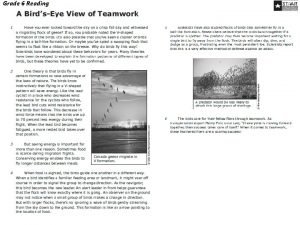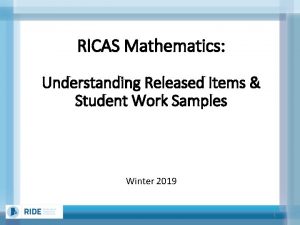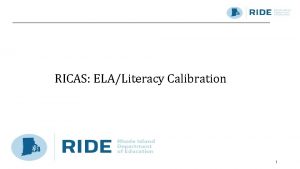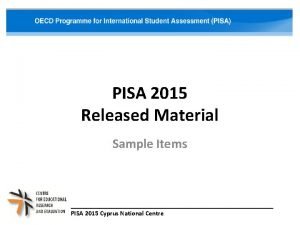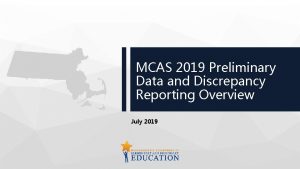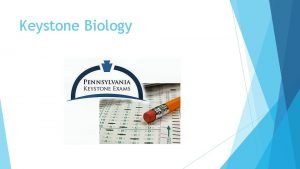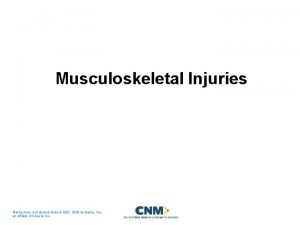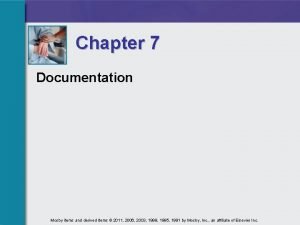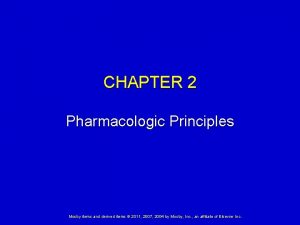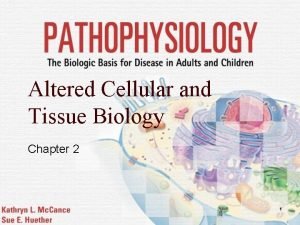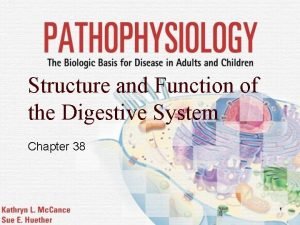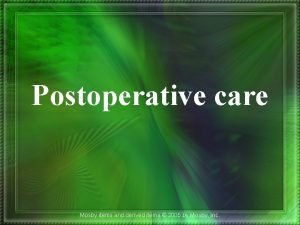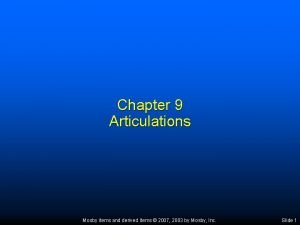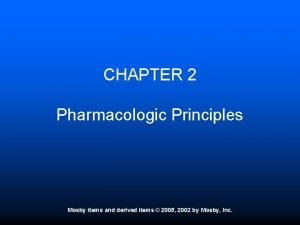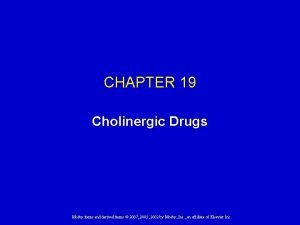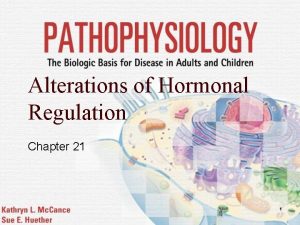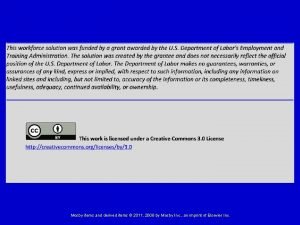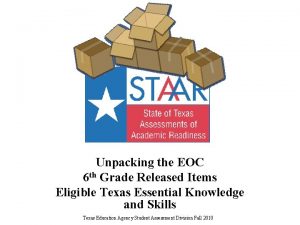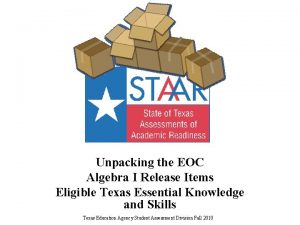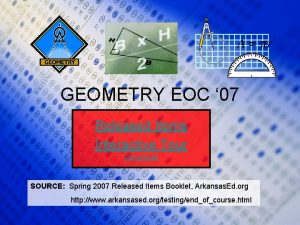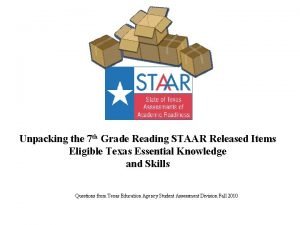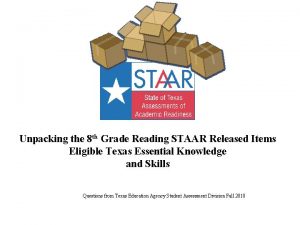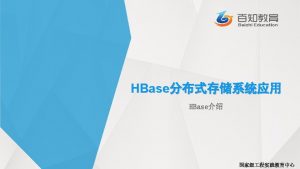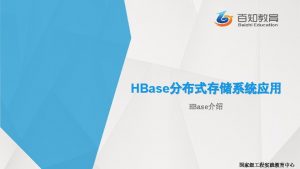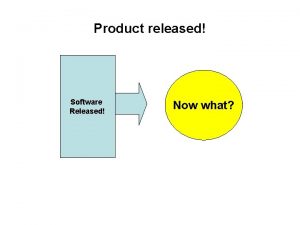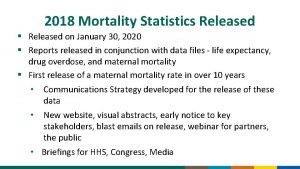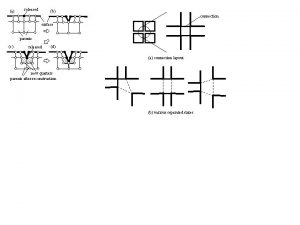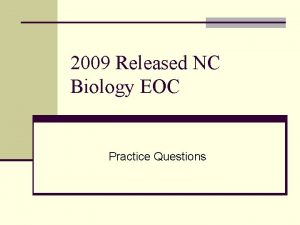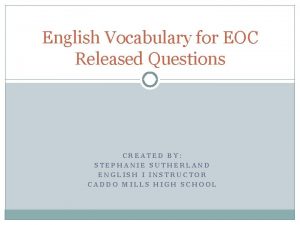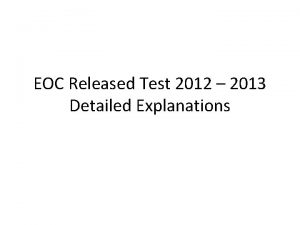Unpacking the EOC 7 th Grade Released Items


















- Slides: 18

Unpacking the EOC 7 th Grade Released Items Eligible Texas Essential Knowledge and Skills Texas Education Agency Student Assessment Division Fall 2010

“Think Around” the question and capture all thoughts by jotting down what is being said. In order for a 7 th grade student to be able to master this question what does the student need to know?

In order for a 7 th grade student to be able to master this question what does the student need to know? Let’s look at Vertical Alignment 2011 7 th Grade STARR Mathematics Released Item~Question 9 Readiness 7. 9. A (6. 8. A) Measurement. The student solves application problems involving estimation and measurement. The student is expected to: 7. 9. A (A) estimate measurements and solve application problems involving length (including perimeter and circumference) and area of polygons and other shapes; 6. 8. A (8) Measurement. The student solves application problems involving estimation and measurement of length, area, time, temperature, volume, weight, and angles. The student is expected to: (A) estimate measurements (including circumference) and evaluate reasonableness of results;

CSCOPE Performance Indicators Please note that Fig. 19 D is assessed through performance indicators in every unit. Only a few were selected for this activity 6 th Grade CSOPE Performance Indicators 7 th Grade CSOPE Performance Indicators Unit 6 Second Nine Weeks Unit 7 Third Nine Weeks Create a presentation (e. g. , poster, web page, etc. ) that displays a Generate a complete model (e. g. , blueprint, design book, etc. ) with labels of angle measures, dimensions, and a geometric classification of each figure in a given real-life problem situation which involves length and area. Use mathematical language to identify a pair of complementary and supplementary angles. Use the complete model to find a reasonable solution to the real-life problem situation. Validate all solutions with a calculator. Write a justification of the solution process describing the mathematical properties, relationships, and formulas used to determine the angles, dimensions, and geometric classifications of the figures in the problem. (7. 2 B, 7. 2 F, 7. 2 G; 7. 3 B; 7. 4 A; 7. 6 A, 7. 6 B; 7. 8 C; 7. 9 A; 7. 13 A, 7. 13 B, 7. 13 C, 7. 13 D; 7. 14 A; 7. 15 A, 7. 15 B) table of data used to generate formulas of perimeter and area involving addition and subtraction of fractions and decimals. Describe the relationships that occur in the table, and estimate measurements using appropriate units, tools, and formulas. Write a justification of the solution process strategies, and validate conjectures used to solve a given real-life problem situation. (6. 2 B, 6. 2 C, 6. 2 E; 6. 4 B; 6. 6 C; 6. 8 A, 6. 8 B; 6. 11 A, 6. 11 B, 6. 11 C, 6. 11 D; 6. 12 A; 6. 13 A, 6. 13 B) Sample Performance Indicator: Cody plans to sell cans of juice for $1. 50 each to raise money for the Austin Blind Salamander. Each can of juice will have a label about the charity that is 9 centimeters tall. Create a poster displaying the appropriate length and area of the label, justifying each step used in the problem-solving strategy (e. g. , drawing a picture, making a table, working a simpler problem, etc. ) to validate reasonableness of the solutions. Sample Performance Indicator: Lisa has decided to replace the grass in her back yard and obtained a blueprint from her contractor. While inspecting the blueprint, she noticed that not all of the measurements were noted for her pond, wooden deck, and patio. She remembered that her yard is 14 yards long and 6 yards wide, the perimeter of the wooden deck is 28. 75 ft, and the semi-circumference of the patio is 12. 56 ft. In addition, use the completed table to generate a formula to find the area, A, of the juice can label that has a height of 9 centimeters and a length of C centimeters, using 3 to approximate pi. Include a caption on your poster that explains the relationships identified between the radius, diameter, and circumference. If Cody’s total cost is 73¢ to purchase and add the label to each can of juice, how much profit (in dollars) will he donate to the Austin Blind Salamander charity for each can of juice he sells? Estimate the amount of money Cody will donate if he sells 100 cans of juice. Create a blueprint of Lisa’s backyard with labels of the angle measures and dimensions of the pond, wooden deck, and patio. Use mathematical language to identify a pair of complementary and supplementary angles and a classification of the geometric shape of the pond and wooden deck. Use the blueprint to determine the amount of grass in square feet Lisa should purchase and a reasonable estimate of the cost if she purchases a square foot of grass for $. 75. Validate all solutions with a calculator. Write a justification of the solution process describing the mathematical properties, relationships, and formulas used to determine the area of the pond, wooden deck, and patio in order to find the amount and cost of grass needed for the backyard.

Examining STAAR 7 th Grade Implications for Teaching Number of Non-linguistic Representation Number of 6 th Grade Aligned SEs Number of 8 th Grade Aligned SEs Formula Chart would be useful DOK Levels Total 1 2 3 4

Taught in CSCOPE 1 st and 4 th nine weeks Units 1, 3, 10, 11, 12 Readiness 7. 1. B (6. 1. B, 8. 1. B) (1) Number, operation, and quantitative reasoning. The student represents and uses numbers in a variety of equivalent forms. The student is expected to: (B) convert between fractions, decimals, whole numbers, and percents mentally, on paper, or with a calculator; Number of steps it takes to solve the problem. 2 -3 steps min What part of the SE is being tested? Convert between fractions to decimals to percents. DOK: Level (Evidence) Level 2 retrieve information from a table and use it to solve a problem requiring multiple steps. Academic Vocabulary Write (S) it is stated and (I) if it is implied Positive rational numbers (i) Percent (s) Fraction (s) How is it being tested? Determining which students grades are above 85% What do the students need to know in order to answer the question correctly? Students must understand that they need to divide the fractions to decimals and then convert to percents. They must then correctly identify which students scores were above 85%

Taught in CSCOPE 1 st, 3 rd and 4 th nine weeks Unit 2, 7, 8, 9, 11, 12 Readiness 7. 2. B (6. 11. C, 8. 14. C) (2) Number, operation, and quantitative reasoning. The student adds, subtracts, multiplies, or divides to solve problems and justify solutions. The student is expected to: (B) use addition, subtraction, multiplication, and division to solve problems involving fractions and decimals; Processing 7. 13. C (6. 11. C, 8. 14. C) (13) Underlying processes and mathematical tools. The student applies Grade 7 mathematics to solve problems connected to everyday experiences, investigations in other disciplines, and activities in and outside of school. The student is expected to: (C) select or develop an appropriate problem-solving strategy from a variety of different types, including drawing a picture, looking for a pattern, systematic guessing and checking, acting it out, making a table, working a simpler problem, or working backwards to solve a problem; Number of steps it takes to solve the problem. What part of the SE is being tested? DOK: Level (Evidence) Academic Vocabulary Write (S) it is stated and (I) if it is implied How is it being tested? What do the students need to know in order to answer the question correctly?

Taught in CSCOPE 1 st and 4 th nine weeks Units 2, 3, 12 Supporting 7. 2. D (6. 2. C, 8. 2. D) (2) Number, operation, and quantitative reasoning. The student adds, subtracts, multiplies, or divides to solve problems and justify solutions. The student is expected to: (D) use division to find unit rates and ratios in proportional relationships such as speed, density, price, recipes, and studentteacher ratio; Process 7. 13. B (6. 11. B, 8. 14. B) (13) Underlying processes and mathematical tools. The student applies Grade 7 mathematics to solve problems connected to everyday experiences, investigations in other disciplines, and activities in and outside of school. The student is expected to: (B) use a problem-solving model that incorporates understanding the problem, making a plan, carrying out the plan, and evaluating the solution for reasonableness; Number of steps it takes to solve the problem. What part of the SE is being tested? DOK: Level (Evidence) Academic Vocabulary Write (S) it is stated and (I) if it is implied How is it being tested? What do the students need to know in order to answer the question correctly?

Taught in CSCOPE st 1 , 3 rd and 4 th nine weeks Units 3, 7, 11, 12 Readiness 7. 3. B (6. 3. C, 8. 3. B) (3) Patterns, relationships, and algebraic thinking. The student solves problems involving direct proportional relationships. The student is expected to: (B) estimate and find solutions to application problems involving proportional relationships such as similarity, scaling, unit costs, and related measurement units. Processing 7. 13. A (6. 11. A, 814. A) (13) Underlying processes and mathematical tools. The student applies Grade 7 mathematics to solve problems connected to everyday experiences, investigations in other disciplines, and activities in and outside of school. The student is expected to: (A) identify and apply mathematics to everyday experiences, to activities in and outside of school, with other disciplines, and with other mathematical topics; Number of steps it takes to solve the problem. What part of the SE is being tested? DOK: Level (Evidence) Academic Vocabulary Write (S) it is stated and (I) if it is implied How is it being tested? What do the students need to know in order to answer the question correctly?

Taught in CSCOPE 2 nd and 4 th nine weeks Units 5, 6, 11, 12 Readiness 7. 5. B (6. 5, 8. 5. A) (5) Patterns, relationships, and algebraic thinking. The student uses equations to solve problems. The student is expected to: (B) formulate problem situations when given a simple equation and formulate an equation when given a problem situation. Processing 7. 14. A (6. 12. A, 8. 15. A) (14) Underlying processes and mathematical tools. The student communicates about Grade 7 mathematics through informal and mathematical language, representations, and models. The student is expected to: (A) communicate mathematical ideas using language, efficient tools, appropriate units, and graphical, numerical, physical, or algebraic mathematical models; Number of steps it takes to solve the problem. What part of the SE is being tested? DOK: Level (Evidence) Academic Vocabulary Write (S) it is stated and (I) if it is implied How is it being tested? What do the students need to know in order to answer the question correctly?

Taught in CSCOPE 3 rd nine weeks Units 7 Supporting 7. 6 B (6) Geometry and spatial reasoning. The student compares and classifies two- and three-dimensional figures using geometric vocabulary and properties. The student is expected to: (B) use properties to classify triangles and quadrilaterals; Processing 7. 13. C (6. 11. C, 8. 14. C) (13) Underlying processes and mathematical tools. The student applies Grade 7 mathematics to solve problems connected to everyday experiences, investigations in other disciplines, and activities in and outside of school. The student is expected to: (C) select or develop an appropriate problem-solving strategy from a variety of different types, including drawing a picture, looking for a pattern, systematic guessing and checking, acting it out, making a table, working a simpler problem, or working backwards to solve a problem; Number of steps it takes to solve the problem. What part of the SE is being tested? DOK: Level (Evidence) Academic Vocabulary Write (S) it is stated and (I) if it is implied How is it being tested? What do the students need to know in order to answer the question correctly?

Taught in CSCOPE 1 st nine weeks Unit 3 Readiness 7. 6. D (8. 6. A) (6) Geometry and spatial reasoning. The student compares and classifies two- and three-dimensional figures using geometric vocabulary and properties. The student is expected to: (D) use critical attributes to define similarity. Processing 7. 14. A (6. 12. A, 8. 15. A) (14) Underlying processes and mathematical tools. The student communicates about Grade 7 mathematics through informal and mathematical language, representations, and models. The student is expected to: (A) communicate mathematical ideas using language, efficient tools, appropriate units, and graphical, numerical, physical, or algebraic mathematical models; Number of steps it takes to solve the problem. What part of the SE is being tested? DOK: Level (Evidence) Academic Vocabulary Write (S) it is stated and (I) if it is implied How is it being tested? What do the students need to know in order to answer the question correctly?

Taught in CSCOPE 2 nd nine weeks Unit 4 Readiness 7. 7. B (8. 6. B) (7) Geometry and spatial reasoning. The student uses coordinate geometry to describe location on a plane. The student is expected to: (B) graph reflections across the horizontal or vertical axis and graph translations on a coordinate plane. Processing 7. 13. D (6. 11. D, 8. 14. D) (13) Underlying processes and mathematical tools. The student applies Grade 7 mathematics to solve problems connected to everyday experiences, investigations in other disciplines, and activities in and outside of school. The student is expected to: (D) select tools such as real objects, manipulatives, paper/pencil, and technology or techniques such as mental math, estimation, and number sense to solve problems. Number of steps it takes to solve the problem. What part of the SE is being tested? DOK: Level (Evidence) Academic Vocabulary Write (S) it is stated and (I) if it is implied How is it being tested? What do the students need to know in order to answer the question correctly?

Taught in CSCOPE st 1 , 3 rd and 4 th nine weeks Units 2, 7, 11 Readiness 7. 9. A (6. 8. A) (9) Measurement. The student solves application problems involving estimation and measurement. The student is expected to: (A) estimate measurements and solve application problems involving length (including perimeter and circumference) and area of polygons and other shapes; Processing 7. 13. B (6. 11. B, 8. 14. B) (13) Underlying processes and mathematical tools. The student applies Grade 7 mathematics to solve problems connected to everyday experiences, investigations in other disciplines, and activities in and outside of school. The student is expected to: (B) use a problem-solving model that incorporates understanding the problem, making a plan, carrying out the plan, and evaluating the solution for reasonableness; Number of steps it takes to solve the problem. What part of the SE is being tested? DOK: Level (Evidence) Academic Vocabulary Write (S) it is stated and (I) if it is implied How is it being tested? What do the students need to know in order to answer the question correctly?

Taught in CSCOPE 3 rd nine weeks Unit 8 Supporting 7. 9. B (8. 8. B) (9) Measurement. The student solves application problems involving estimation and measurement. The student is expected to: (B) connect models for volume of prisms (triangular and rectangular) and cylinders to formulas of prisms (triangular and rectangular) and cylinders; Processing 7. 14. A (6. 12. A, 8. 15. A) (14) Underlying processes and mathematical tools. The student communicates about Grade 7 mathematics through informal and mathematical language, representations, and models. The student is expected to: (A) communicate mathematical ideas using language, efficient tools, appropriate units, and graphical, numerical, physical, or algebraic mathematical models; Number of steps it takes to solve the problem. What part of the SE is being tested? DOK: Level (Evidence) Academic Vocabulary Write (S) it is stated and (I) if it is implied How is it being tested? What do the students need to know in order to answer the question correctly?

Taught in CSCOPE 3 rd and 4 th nine weeks Units 8, 11 Readiness 7. 9 C (6. 8. B, 8. 8. C) (9) Measurement. The student solves application problems involving estimation and measurement. The student is expected to: (C) estimate measurements and solve application problems involving volume of prisms (rectangular and triangular) and cylinders. Number of steps it takes to solve the problem. What part of the SE is being tested? DOK: Level (Evidence) Academic Vocabulary Write (S) it is stated and (I) if it is implied How is it being tested? What do the students need to know in order to answer the question correctly?

Taught in CSCOPE rd 3 nine weeks Unit 9 Readiness 7. 11. B (11) Probability and statistics. The student understands that the way a set of data is displayed influences its interpretation. The student is expected to: (B) make inferences and convincing arguments based on an analysis of given or collected data. Processing 7. 15. B (6. 13. B, 8. 16. B) Underlying processes and mathematical tools. The student uses logical reasoning to make conjectures and verify conclusions. The student is expected to: (A) make conjectures from patterns or sets of examples and nonexamples; and (B) validate his/her conclusions using mathematical properties and Number of steps it takes to solve the problem. What part of the SE is being tested? DOK: Level (Evidence) Academic Vocabulary Write (S) it is stated and (I) if it is implied How is it being tested? What do the students need to know in order to answer the question correctly?

Taught in CSCOPE rd 3 nine weeks Unit 9 Readiness 7. 12. B (8. 12. A) (12) Probability and statistics. The student uses measures of central tendency and variability to describe a set of data. The student is expected to: (B) choose among mean, median, mode, or range to describe a set of data and justify the choice for a particular situation Number of steps it takes to solve the problem. What part of the SE is being tested? DOK: Level (Evidence) Academic Vocabulary Write (S) it is stated and (I) if it is implied How is it being tested? What do the students need to know in order to answer the question correctly?
 6th grade reading staar
6th grade reading staar Ricas release items
Ricas release items Ricas rubric
Ricas rubric Pisa released items
Pisa released items Biology mcas 2019
Biology mcas 2019 Biology keystone study guide
Biology keystone study guide Mosby items and derived items
Mosby items and derived items Acuity charting forms
Acuity charting forms Mosby items and derived items
Mosby items and derived items Altered cellular and tissue biology
Altered cellular and tissue biology Mosby items and derived items
Mosby items and derived items Mosby items and derived items
Mosby items and derived items Mosby items and derived items
Mosby items and derived items Mosby items and derived items
Mosby items and derived items Lliver
Lliver Mosby items and derived items
Mosby items and derived items Mosby items and derived items
Mosby items and derived items Mosby items and derived items
Mosby items and derived items Mosby items and derived items
Mosby items and derived items
